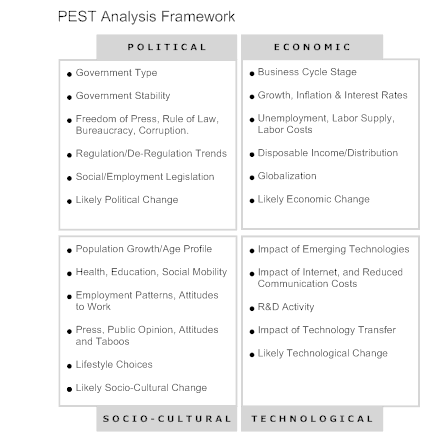
PEST Analysis
Understanding "Big Picture" Forces of Change
(Also known as PESTLE, PESTEL, PESTLIED, STEEPLE and SLEPT Analysis)
PEST Analysis is a simple, useful and widely-used tool that helps you understand the "big picture" of your Political, Economic, Socio-Cultural and Technological environment. As such, it is used by business leaders worldwide to build their vision of the future.
- By making effective use of PEST Analysis, you ensure that what you are doing is aligned positively with the forces of change that are affecting our world. By taking advantage of change, you are much more likely to be successful than if your activities oppose it.
-
Good use of PEST Analysis helps you avoid taking action that is condemned to failure from the outset, for reasons beyond your control. - PEST is useful when you start operating in a new country or region. Use of PEST Analysis helps you break free of unconscious assumptions, and helps you quickly adapt to the realities of the new environment.
How to Use the Tool:
PEST is a simple mnemonic standing for Political, Economic, Socio-Cultural and Technological.
To use this tool, follow this three stage process:
- Brainstorm the relevant factors that apply to you, using the prompts below.
- Identify the information that applies to these factors.
- Draw conclusions from this information.
The following prompts may help as a starting point for brainstorming (but make sure you include other factors that may be appropriate to your situation):
Political:
-
Government type and stability. -
Freedom of press, rule of law and levels of bureaucracy and corruption. -
Regulation and de-regulation trends. -
Social and employment legislation. -
Tax policy, and trade and tariff controls. -
Environmental and consumer-protection legislation. -
Likely changes in the political environment.
Economic:
-
Stage of business cycle. -
Current and projected economic growth, inflation and interest rates. -
Unemployment and labor supply. -
Labor costs. -
Levels of disposable income and income distribution. -
Impact of globalization. -
Likely impact of technological or other change on the economy. -
Likely changes in the economic environment.
Socio-Cultural:
-
Population growth rate and age profile. -
Population health, education and social mobility, and attitudes to these. -
Population employment patterns, job market freedom and attitudes to work. -
Press attitudes, public opinion, social attitudes and social taboos. -
Lifestyle choices and attitudes to these. -
Socio-cultural changes.
Technological Environment:
-
Impact of emerging technologies. -
Impact of Internet, reduction in communications costs and increased remote working. -
Research and development activity. -
Impact of technology transfer.
These are shown in Figure 1 below:
Figure 1: PEST Analysis

| Other forms of PEST - PESTLE, PESTLIED, STEEPLE and SLEPT: Some people prefer to use different flavors of PEST Analysis. These are:
|
Example:
We’re going to avoid giving an example here, because of the huge potential for causing offense: few societies seem perfect to outsiders, and there are few things as irritating as having an outsider criticize one's own country...
However, a broad principle is that things that make economic activity more difficult for people or organizations raise the cost of doing business: business is either stopped altogether, or it costs more as people spend time and money circumventing difficulties. The higher the cost of doing business in a region, the more project profitability is squeezed, meaning that businesses and projects that could otherwise operate are never launched. In turn, this means that less economic activity takes place, and people are poorer.
Another broad principle is wherever there is rapid or major change in an area, there are likely to be new opportunities and threats that arise. Smart people and companies will take advantage of the opportunities and make money helping others manage the threats.
And do remember that few situations are perfect: it is up to us to make the most of the situation in which we find ourselves.
Key Points:
PEST Analysis is a useful tool for understanding the ‘big picture’ of the environment in which you are operating, and for thinking about the opportunities and threats that lie within it. By understanding your environment, you can take advantage of the opportunities and minimize the threats.
PEST is a mnemonic standing for Political, Economic, Social and Technological. These headings are used firstly to brainstorm the characteristics of a country or region and, from this, draw conclusions as to the significant forces of change operating within it.
This provides the context within which more detailed planning can take place, so that you can take full advantage of the opportunities that present themselves.











0 comments:
Post a Comment